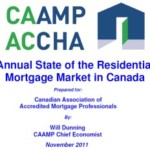Annual State Of The Residential Mortgage Market In Canada 2011 Brief Introduction

The Canadian Association of Accredited Mortgage Professionals released their “Annual State of the Residential Mortgage Market in Canada – November 2011”. According to the report the average mortgage growth is expected to be 7.3 percent in 2012, besides, it is increasingly expected about mortgage interest rates that will remain low for a prolonged period, so Canadian consumer can get best mortgage rates in coming future. Here is the brief overlook of this report.
Introduction and Summary
This is the seventh annual report on the State of the Residential Mortgage Market in Canada. It has been prepared for the Canadian Association of Accredited Mortgage Professionals (“CAAMP”) by Will Dunning, Chief Economist of CAAMP. It provides an overview of the evolving state of the residential mortgage market in Canada. Major sections of this report are:
- Introduction and Summary
- Consumer Responses to Topical Questions
- Consumer Choices and Satisfaction
- Outlook for Residential Mortgage Lending
Data used in this report was obtained from various sources, including an online survey of 2,000 Canadians. More than one-half of the sample (1,031 Canadians) were homeowners who have mortgages and/or other debt on their property. The remainder included renters, homeowners without debts on their properties, or others who live with their families and are not responsible for mortgage payments or rents. The survey was conducted for CAAMP by Maritz (a national public opinion and market research firm) from October 20 to 25, 2011.
Consumer Responses to Topical Questions
In the Fall 2010 and 2011 editions of the CAAMP survey, consumers’ opinions were sought on several issues, related to housing and mortgages, that have taken on high profiles in the media. The consumers were asked to what extent they agree with various statements, on a 10-point scale: a response of 10 indicates that they agree completely with the statement and a response of 1 indicates they disagree completely. Average scores of 5.5 would indicate neutral opinions.
The table below summarizes the responses. Results are presented in substantially more detail in the body of the report (starting at Page 9).
For all of the questions, responses varied widely, and it is challenging to generalize about consumers’ attitudes. Highlights include:
- The statement that found the highest degree of agreement (an average rating of 7.98 out of 10) is that “as a whole, Canadians have too much debt”. Almost one-half (46%) gave ratings of 9 or 10, showing very strong agreement with this statement. This, coincidentally or not, has been asserted repeatedly by senior government officials and other voices in the news media.
- There is also agreement (average rating of 7.11 out of 10) that “low-interest rates have meant that a lot of Canadians became homeowners over the past few years who should probably not be homeowners”.
- However, different perspectives were found with several other questions.
- There is a widespread opinion that “real estate in Canada is a good long-term investment”, which received the second-highest rating, an average of 7.27 out of 10.
- Furthermore, there was a high degree of agreement that mortgage debt is “good debt (7.07 out of 10).
- In addition, in a statement that was asked for mortgage holders only, a few agreed that “I regret taking on the size of mortgage I did”. The average score of 4.04 was well below neutral. Just 7% agreed strongly with the statement; 37% strongly disagreed.
- Many Canadians believe that other people have taken on too much debt or have bought homes for which they are unprepared. But, when responses about their own situations are aggregated, most believe that they have been responsible. The contrast between these sets of responses is interesting. Actual behaviour by people and their beliefs about their own behaviour tells us more than does their beliefs about the behaviour of other people: overall these responses suggest that prudence rules the land.
- Meanwhile, data on mortgage arrears indicates that there are very few Canadians who are not meeting their mortgage obligations, and estimates developed in this report indicate that a vast majority of Canadian mortgage borrowers are well-positioned to deal with potential increases in mortgage rates. Moreover, they are acting aggressively to pay off their mortgages, considerably more rapidly than they are required to.
Consumer Responses to Topical Questions
Average Responses (10 = Completely Agree)
| Topic | Fall 2011 |
|---|---|
| Canada’s housing market is in a “bubble” | 6.07 |
| I am concerned about a downturn in Canada’s housing market in the next year | 5.84 |
| Canada’s superior banking system will shelter us from significant downturns like the one experienced by the United States | 6.11 |
| As a whole, Canadians have too much debt | 7.98 |
| House prices in my community are at a reasonable level | 5.62 |
| Low interest rates have meant that a lot of Canadians became home owners over the past few years who should probably not be home owners | 7.01 |
| I/My family would be well-positioned to weather a potential downturn in home prices | 6.72 |
| Real estate in Canada is a good long-term investment | 7.27 |
| I am optimistic about the economy in the coming 12 months | 6.02 |
| I regret taking on the size of mortgage I did | 4.04 |
| I am delaying my retirement until my mortgage is paid off | 5.38 |
| I would classify mortgages as “good debt” | 7.07 |
Consumer Choices and Satisfaction
The survey found that Canadians remain highly satisfied with the terms of their mortgages, and their experiences in obtaining their mortgages:
- 13% indicate they are completely satisfied with the terms of their mortgages (giving a rating of 10 out of 10) and a further 58% are satisfied (ratings of 7 to 9 out of 10). Combining these results, 71% are satisfied to some degree.
- 21% give a neutral satisfaction rate (5 or 6 out of 10).
- Just 8% are dissatisfied to some degree (1 to 4 out of 10).
- On average, the satisfaction rate is 7.4 out of 10.
Satisfaction with mortgage experiences was very similar, and the average rating was fractionally higher, at 7.6 out of 10. Older age groups are more satisfied with their mortgages and their mortgage experiences than are younger age groups. There are some variations across different groups.
About one-third (32%) of homeowners with mortgages had some form of mortgaging activity during the past 12 months: taking out a new mortgage (9%), or renewing or refinancing an existing mortgage (23%). The remainder (68%) did not have any mortgaging activity during the year.
Among those who renewed or refinanced an existing mortgage during the past 12 months, 21% changed lenders and 79% remained with the same lender. The rate of switching has edged upwards – two years ago it was 12%.
Concerning types of mortgages, fixed-rate mortgages remain the most popular (60%). A significant minority (31%) are variable and adjustable-rate mortgages. For mortgages originated or renewed during the past year, an increased share (37%) has variable or adjustable rates. This shift may be due to the large spread between rates for fixed-rate and variable-rate mortgages (close to 2% during the past year). As well, it is increasingly expected that mortgage interest rates will remain low for a prolonged period. Both of these factors are encouraging borrowers to accept the risk that the payments will increase for variable-rate mortgages.
With regard to mortgage amortization periods, 22% of mortgages in Canada have amortization periods of more than 25 years. The share is higher (38%) among homeowners who, during 2011, took out a new mortgage on a newly-purchased home or condominium.
Looking at interest rates, the CAAMP/Maritz data indicates that:
- The average mortgage interest rate for homeowners’ mortgages is 3.92%, a drop from 4.22% a year earlier.
- For borrowers who have renewed or refinanced a mortgage during the past year, their current average interest rate is lower (by 1.24 percentage points) than the rates prior to renewal. Among borrowers who renewed, a large majority (78%) saw reductions, a smaller proportion (13%) saw their rates rise, and 9% had no change. Based on the survey data, it is estimated that among 1.35 million mortgage borrowers who renewed or refinanced in the past year, the combined saving was $2.7 billion per year.
Mortgage rate discounting remains widespread in Canada. During the past year, the average “posted” rate for 5-year fixed-rate mortgages was 5.38%. Discounted rates are estimated at an average of 3.92%, implying an average discount of 1.46 points.
Given concerns that have been expressed about consumers’ abilities to cope with potential rises in interest rates, this issue of CAAMP’s “Annual State of the Residential Mortgage Market” asked mortgage holders to indicate “the amount at which, if your monthly mortgage payment increased this much, you would be concerned with your ability to make your payments”. The average amount of room is $750 per month on top of their current costs. A vast majority of mortgage holders have considerable capacity to afford rises in mortgage interest rates. There is a sizable minority (12%, or about 650,000 out of 5.80 million) who would be challenged by rate rises of less than 1%. However, most of these have fixed-rate mortgages: by the time their mortgages are due for renewal, their financial capacity will have increased and the amount of mortgage debt will be reduced. Moreover, most of these borrowers (88%) have 10% (or more equity) in their homes. There are about 75,000 borrowers who are susceptible to short term moves of interest rates and have limited home equity – less than 2% of the 5.8 million mortgage holders in Canada.
This study asked questions that generated estimates of home owners’ equity.
- The total value of owner-occupied housing in Canada is estimated at $3.017 trillion. Mortgages and lines of credit on these homes total $982 billion, leaving $2.035 trillion in homeowners’ equity. The equity is equal to 68% of the total value of the housing.
- Among homeowners who have mortgages and/or lines of credit on their homes, 2% might have negative equity, and a further 4% have estimated equity of less than 10%. More than three-quarters (78%) have 25% or more equity.
The survey data indicates that 10% of mortgage borrowers took equity out of their homes in the past year. The average amount is estimated at $49,000. These results imply that the total amount of equity take-out during the past year has been $28.5 billion. The most common use for the funds from equity take-out is debt consolidation and repayment, which accounted for $11 billion. This part of the total equity take-out would result in corresponding reductions for other forms of consumer debt. Home renovations accounted for about $5 billion of the equity take-out, with $6 billion for education and another spending, $3.5 billion for investments, and $3 billion for “other” purposes.
Among borrowers who have taken out a new mortgage during the past year, 52% obtained the mortgage from a bank, 32% from a mortgage broker, and 16% from other sources.
Outlook for Residential Mortgage Lending
Gradual recovery from the recession of 2008/09 has brought stabilization of housing activity, but at lower levels than pre-recession. The consensus of forecasts is for a continued moderate rate of job creation, which is expected to result in housing activity similar to recent levels, for both resales and new homes. These levels of activity are strong enough to support stable or slowly rising housing values: the average of forecasts is for house price growth of about 1% in 2012, a slowdown from the very strong growth of 7.7% expected for 2011.
As of this August, there is $1.079 trillion of residential mortgage credit outstanding in Canada. This includes both owner-occupied and investor-owned residential properties.
Based on the housing market forecasts, the volume of residential mortgage credit outstanding is forecast to continue expanding. Growth is forecast at about 7.7% during 2011 ($80 billion) and 7.3% in 2012 ($81 billion). A preliminary look at 2013 suggests growth of 7.0% ($83 billion).
While the forecasts for the economy, housing market, and mortgage market are encouraging, there is, as always, uncertainty about the outlook. In Canada, the largest risk factor for the mortgage market is “loss of ability to pay” (that is, job loss or a reduction of wages).
Data published by the Canadian Bankers Association shows that the gradual recovery from the recession is resulting in a gradually falling rate of mortgage arrears.
An increasing level of uncertainty about economic prospects is creating uncertainty about the outlook for the housing and mortgage markets.
The risk factor that gets the greatest amount of attention in Canada might be characterized as “an unaffordable rise in mortgage costs”. CAAMP’s research has repeatedly found that this is a negligible risk factor for Canada at present.
Thus, there are risks of outcomes worse than these forecasts. If that occurs, the cause will have been events in the broader economy. The US’s enormous economic difficulties started in the housing and mortgage markets. That will not be the case in Canada.
Looking for the full report, click here to download it from its official location (Canadian Association of Accredited Mortgage Professionals), its 34 pages PDF ebook that requires an Adobe Acrobat Reader to open the report. Source: Annual State of the Residential Mortgage Market in Canada, Nov 2011, CAAMP.
Disclaimer! This report has been compiled using data and sources that are believed to be reliable. CAAMP, Maritz, Will Dunning, and Will Dunning Inc. accept no responsibility for any data or conclusions contained herein. The opinions and conclusions in this report are those of the author and do not necessarily reflect those of CAAMP or Maritz.
Compare and Find Best Mortgage Rates in Canada!




